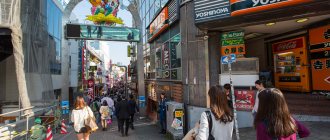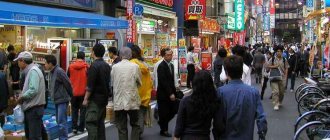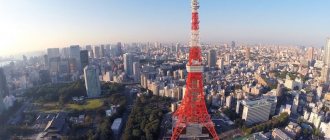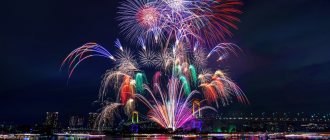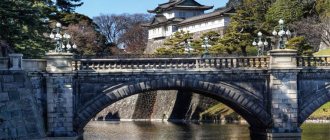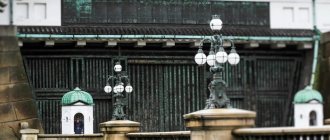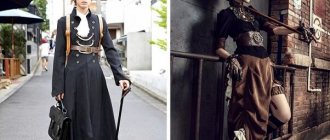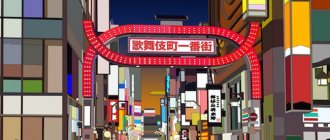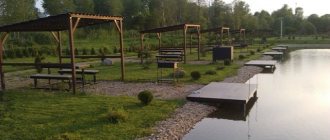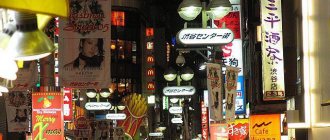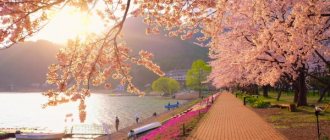Tokyo Olympics 1964: introducing young people to foreign culture
The birthplace of the now world-famous kawaii culture (link in English), on the wave of popularity of which the star of Kyari Pamyu Pamyu rose in the horizon of Japanese show business, is called the Tokyo quarter of Harajuku.
In fact, this is the name of several blocks located between the railway station of the same name and Omotesando Avenue. Here is the favorite restaurant of the king of the guitar, Eric Clapton, as well as a special railway platform intended for the imperial train. During the Edo era (1603-1868) in this area, which was then called Sendagahara, there were many Yado or Shuku (juku) inns - hence the modern name of the quarter.
After World War II, American military barracks were built in Harajuku. Gradually, stores targeting American customers began to open along Omotesando Avenue, such as Kiddy Land and Oriental Bazaar (links in English). The area later became a center for youth fashion, and the turning point in this metamorphosis was the 1964 Tokyo Olympics, when an Olympic village was set up in Yoyogi Park near Harajuku Station. The area was flooded with foreigners, and Japanese youth poured in. Very quickly, Harajuku became a symbol of youth culture.
Story
The Harajuku neighborhood owes its fashionable style to the events at the end of World War II. This is where American soldiers and their families settled after defeating Imperial Japan. As a result, Japanese youth got the opportunity to become more familiar with Western culture, fashion and American customs, thereby creating their own fashion world. Harajuku has become a symbol of an unexpected encounter with Western civilization.
The consequences of this process were not long in coming - in 1958, the construction of fashion workshops for fashion designers began here, and modeling agencies and photo studios were opened. The Summer Olympic Games in Tokyo in 1964 gave Harajuku a new impetus for development. At the end of the games, the fashionable youth of the area received a new name - Harajuku-zoki.
The modern quarter of Harajuku is a green neighborhood between the districts of Shinjuku and Shibuya, dictating authoritative street fashion. On one side it is adjacent to Jingu Gaien Park and Yoyogi Park, and on the other is the elegant Aoyama district. There are only two streets in the block - Omotesando and Takeshita. This is where you can buy unusual stylish clothes and accessories that modern Japanese youth so often flaunt.
Harajuku is also compared to the Champs Elysees in Paris, because there are all the same fashion stores here - Prada, Louis Vuitton, Chanel, etc. Another famous shopping center in the quarter among tourists is the Omotesando Hills, below you will find a photo of this architectural landmark of the area.
Three different Harajuku: Takeshita-dori, Ura-Harajuku, Omotesando
Entrance to Takeshita-dori Street
You can see completely different fashion styles in different parts of Harajuku. Takeshita-dori Street runs from Harajuku Station to Meiji-dori Street. Everything here is designed for teenage girls: fashionable and casual clothes, fashionable little things, sweets are sold here, there are stoen stores and shops “everything for 390 yen” and much more. This part of Harajuku is very popular with high school students from various regions of Japan who come to Tokyo on school trips. It is also popular among foreign tourists.
The part of the neighborhood between Cat Street and Harajuku-dori Street is called "Ura-Harajuku" (or Urahara; map in Japanese and English). There are clothing stores in the Lolita and Gothic Lolita styles, multi-brand designer boutiques (the so-called select shops), vintage clothing stores and cafes.
Amarori (“Sweet Loli”) is one of the directions of the “Lolita” subculture
Omotesando Avenue features all the leading fashion brands, both Japanese and international. You can experience high fashion and haute cuisine in shopping and entertainment centers and arcades such as Laforet Harajuku, Q PLAZA HARAJUKU, Omotesando Hills and others.
In December 2014, tourist information booths MOSHI MOSHI BOX (link in English) appeared on Meiji-dori Street. Here you can get information in English, buy souvenirs, use wireless Internet, change currency in specially equipped machines, send a parcel abroad and get help in finding temporary housing in Japan and abroad. In addition, in August 2015, Sebastian Masuda opened a cafe here called KAWAII MONSTER CAFÉ (link in English).
Omotesando Hills
Information booth for tourists MOSHI MOSHI BOX
Kawaii culture: a successful start
A symbol of fashion culture, kawaii singer Kyari Pamyu Pamyu (links here and below in English) also began her creative journey in Harajuku. Influenced by American singer Gwen Stefani, who performed the song Harajuku Girls, Kyary recorded her debut mini-album Moshi-Moshi Harajuku.
On the second floor of the SoLaDo shopping and entertainment center
Since kawaii culture became popular, trendy youth venues have opened one after another in Harajuku - CUTE CUBE HARAJUKU, HARAJUKU ALTA, SoLaDo, Q PLAZA HARAJUKU and other shopping centers. And veteran stores are also being transformed - for example, the kingdom of toys, souvenirs and memorabilia Kiddy Land on Omotesando Avenue recently opened its doors after reconstruction.
Among young people who are passionate about fashion, it is considered status to appear on the pages of a fashion magazine as a random model caught by a photographer on the streets of Harajuku. And to get into this frame, called “sutosuna” (from street snap), fashionistas go to all sorts of tricks. This can be seen when crossing Jingu Crossing towards Omotesando, or at the entrance to Cat Street in Ura-Harajuku - fame seekers stand there striking various model poses.
What is Harajuku?
In my articles I often mention this place: and not only as a city landmark, but rather as the habitat of all these strange Japanese subcultures. Let's take a closer look at the cradle of frantic Tokyo fashion.
Harajuku is one of the largest trading bases in central Tokyo. This is an area where renting land is incredibly expensive and, accordingly, prices in local stores are noticeably high. Now it is no longer just a district, but the center of the fashion industry not only in Tokyo, but throughout the world. And Omotesando Street is equated to the Champs Elysees in Paris, where the largest stores Louis Vuitton, Chanel and Prada are located.
Harajuku style became a trend after World War II. Before the war, there was a small village on this site, where mainly low-class samurai lived with their families. After the war, the Americans built their barracks there, which they proudly nicknamed Washington Heights. And serious Japanese youth tried to borrow Western style, shopping in local shops owned by Americans. And what came out of the mixture of American and Japanese fashion inspired Japanese designers to create a unique style.
In 1964, the Olympic Village was opened there for visiting athletes, and when a crowd of tourists went to Harajuku to see the Olympians, they could watch a fashion show from Japanese designers - the so-called “Harajuku procession”. In 1978, the fashion house Laforet opened in Harajuku and became one of the main attractions of the area.
In America, the Harajuku style became popular thanks to Gwen Stefani, when she left the group and began a solo career, taking on a team of 4 Japanese girls as backup dancers, which later also became a kind of trend.
Harajuku is home to branches of famous fashion houses from around the world, and small local businesses right next to them. Some items can only be found in Harajuku and only in one store. Also, young designers and artists who try themselves in this difficult business open their own stores in Harajuku.
Hanging out on the streets of Harajuku is that small percentage of Japanese who at one time did not follow a single path (単線型 (tansenkei): school - university - work in a company - the dull life of a sarariman - family). These are beauty school pupils/students, designers, consultants in local stores, models, artists, musicians. Sometimes you can even meet a visual performer somewhere in a store; they stroll peacefully through Omotesando or Takeshita. Local magazines or just informal enthusiasts periodically organize fashion shows on the streets, and some stores host festivals and fashion shows.
The style of youth from Harajuku has several distinctive features:
1. Mixing of cultures.
Kimono with platform boots? Easily. Yukata with mohawk? As easy as pie. Complete freedom and flight of fancy.
2. Layered clothing.
Pulling a T-shirt over a sweater and throwing a jacket on top, or putting a skirt on trousers - only the Japanese can do this.
3. Handmade.
Harajuku youth love to go beyond store fashion by creating something new with their own hands. They don’t stop at torn jeans, but come up with unique models, armed with threads, scissors, buttons and sequins.
4. Accessories.
You can attach the entire arsenal of hairpins from “Children’s World” to your bangs, and they will accept you as one of their own. The wildest combinations of jewelry, and their unlimited quantity. The same applies to piercings: guys with 20 earrings in one ear and two tunnels, or a girl with five barbells in her tongue.
5. Hair and makeup.
Again, complete freedom to choose color and hair length: ponytails, braids, visual hairstyles, mohawks, straight long hair. You can do whatever you want.
6. Don't be shy.
You can put on anything, even a potato sack, the main thing is not to be ashamed of yourself. There you will be accepted as anyone. Even if you are not Asian, to the youth of Harajuku you will be beautiful in any form.
7. Chiizu!
The main thing, while in a suitable outfit or even in home pajamas, while in Harajuku, is to smile in time, make peace with your fingers and say “Chiizu” when you are photographed.
Purikura and delicious food - Harajuku is first in everything
Harajuku is known as the source of "culinary booms" - this is where the fashion for pancakes, popcorn in different flavors and French pancakes originated. On weekends, you can wait an hour in line for pancakes or popcorn, which are sold in specialty stores and shops. And the French crepes, which have long been sold on Takeshita-dori Street, are especially in demand because they can be eaten on the go.
Takeshita-dori is home to the city's largest purikura photo booth center, SHOP NOA (link in Japanese), which features exclusive, only-there "Tokyo" photo frames - so there are always a lot of tourists and high school girls wanting to make commemorative photograph.
Pancakes / Showcase of a shop specializing in French pancakes
If you are tired of the city noise, then your best option is to go for peace and quiet to the Meiji Jingu Shrine, located west of Harajuku Station on an area of 700 thousand square meters. In addition, not far from the station is Yoyogi Park, the fifth largest in Tokyo. The park has an outdoor stage and cycling route, and a stadium will be built there for the 2021 Tokyo Olympics.
Meiji-jingu
See also:
HARAJYUKU KAWAII!! STYLE (English) Tokyo Pocket Guide/Harajyuku (English) Go Tokyo (English) Tour of Harajuku (Japanese)
Banner photo: Takeshita-dori
Tokyo Harajuku district
Attractions
Below we will look at the main attractions that a tourist should visit.
Eega National Sports Hall. It was designed by renowned architect Kenzo Tange for the 1964 Olympic Games. It is a short walk from the metro station. Olympic competitions are also planned to be held here in 2021.
Gyre Shopping Centre. Notable for its architecture and interior. The building is designed in a spiral shape.
Dior Omotesando brand clothing store. Architects Kazuyo Sejima and Ryue Nishizawa designed the house visually dressed in a skirt, symbolizing the femininity and elegance of Dior.
Omotesando Hills. Despite the name, this is a shopping center. What makes it unusual is that more than half of it is underground. Architect Tadao Ando thus decided to create a structure that would not spoil the view of the surrounding landscape with its height. There are not only shops, but also beauty salons, cafes and restaurants.
Prada Aoyama. A large fashion store that looks truly luxurious due to the gold glitter finish of the building.
Nezu Museum. Masterpieces of Japanese art are stored here. The author of this project is Kengo Kuma. On the territory there is an open space of 17 thousand square meters with a gorgeous view of the beautiful garden.
Department store Laforet Harajuku. This department store is well known to local fashionistas. Here on the 6th floor there is an art museum of the history of fashion.
Omotesando Boulevard. There is a very dense concentration of expensive boutiques and designer shops here.
Louis Vuitton. The stylish building was designed by Jean Eoki. They say that it is simply impossible to walk past the building and not stare at it.
Tokyu Plaza Omotesando Harajuku. One of the new shopping centers, opened in 2012. On the top floor there is a green terrace.
Daiso Harajuku. Large center with goods for 100 yen. There is a wide selection here: food, stationery, household goods, etc.
Oriental Bazaar. Large souvenir shop. There are always a lot of tourists here who want to buy souvenirs for memory or for their family. The building is made in Japanese traditions.
Kiddy Land. One of the most popular children's toy stores with 5 floors.
Meiji. Shinto shrine dedicated to the emperor and his wife.
Togo. Shinto shrine dedicated to Admiral Togo. There used to be an antiques market here, but it has ceased operation since 2009.
How to get to Harajuku .
The JR train runs here on the Yamanote Line between Shinjuku and Shibuya stations. Application
